While the industry initially developed drones to deliver payloads and observation, the technology has evolved far more. Miniaturisation and commercial viability now mean that drones are considered for everything from filming Hollywood movies to effortlessly delivering packages. However, one of the most innovative uses of drones is as an art form. Combined with music, narrative, and imagination, drone art is now wowing audiences everywhere, regularly featuring at some of the world’s most significant events.
Defining drone art
Drone art depends on collaboration between cutting-edge technology and artistic vision. These displays see hundreds, if not thousands, of drones with LED lights capable of emitting colours. An animation and creative team then design and program the drones to co-ordinate and illuminate the sky with intricate formations that are visually mesmerising even to modern audiences.Purposes such as brand activation[1], advertising, and other marketing efforts, drone art displays are primarily being leveraged by the events industry for entertainment.
Limitless potential
The events industry is, therefore, increasingly turning to drones to offer a safer alternative that leaves a lasting, emotional response within audiences. In the night sky or indoor spaces, drones entirely use the space available, treating the air as a type of canvas to produce vivid, beautiful art.For example, Saudi Arabian entertainment festival Riyadh Season 2021 kicked off the celebrations with an incredible drone art demonstration. While carefully planned firework displays can make some shapes, drone art takes this to another level. With each drone essentially acting as an individual pixel, the sky becomes a display, with artistic vision able to be impressed upon it, immediately reaching hundreds of thousands of people at once.
Storytelling
Drones can replicate traditional art, too, bringing it to life before the eyes of audiences with narrative and storytelling.In December 2018, Van Gogh’s iconic “Starry Night” was reimagined in the new art medium using 600 drones. The scene lasted over 26 minutes, with audiences in awe of the detailed, animated scenes depicted above their heads. Seamlessly in sync, the drones generated 12 images a second to create smooth animations. These included the blooming of sunflowers, the creation of Van Gogh’s self-portrait, and the closing of a book to signify the artist’s death.In tighter spaces, geofencing and location sensors mean drones can operate even in more intimate areas. For example, for the recent Queen’s Platinum Jubilee celebrations, audiences were treated to a 400 drone art display. The drones swarmed the air, dynamically changing colour and shape to produce visual artwork such as an iconic corgi, a traditional cup of tea, and a distinctive stamp.Drones allow art to tell a story and leave a lasting impression on audiences, especially when combined with music. These larger-than-life spectacles elicit emotional responses within people and add another string to the bow of artists and event organisers everywhere.
Safer, more sustainable events
Drone art is incredibly safe and sustainable.While fireworks have been the go-to for the events industry to command attention, a loud bang and short-lived burst of light are often not enough in modern times. Whatsmore fireworks involve toxic chemicals that are proven to cause health risks to people and animals and harm the immediate environment. In addition, the carbon footprint of producing and displaying fireworks is often not worth the cost, especially for extended displays that audiences can become fatigued with.Using drones to display artistic vision is a much more responsible way to impress audiences. Drone teams will typically scout locations using scanning technology and implement safety measures that ensure audiences are never in danger. In the cases of extreme weather such as high winds, the drones automatically lower themselves to the ground. The sound of the drones, too, is often indistinguishable, especially with music accompanying the art displays. This makes them suitable for a wider audience than firework displays.The future of drone art will see direct interaction between performers and the machines themselves. Motion capturing technology is beginning to allow dance troupes, magicians, artists, and other entertainers to express their creativity in never before seen ways.As technology evolves, we can expect this integration between technology and art to be used in even more creative ways within the events industry. Opportunity for internal linking
Image supplied by HighGreat drone light shows
